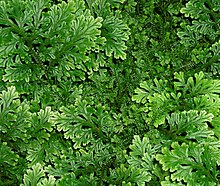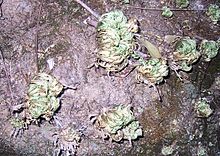| Spikemoss Temporal range:
| |
|---|---|

| |
| Scientific classification | |
| Kingdom: | Plantae |
| Clade: | Tracheophytes |
| Clade: | Lycophytes |
| Class: | Lycopodiopsida |
| Order: | Selaginellales Prantl |
| Family: | Selaginellaceae Willk. |
| Genus: | Selaginella P. Beauv. |
| Type species | |
| Selaginella selaginoides | |
| Species | |
|
See text. | |
| Synonyms | |
| |


Selaginella, also known as spikemosses or lesser clubmosses is a genus of lycophyte. It is usually treated as the only genus in the family Selaginellaceae, with over 750 known species.
This family is distinguished from Lycopodiaceae (the clubmosses) by having scale-leaves bearing a ligule and by having spores of two types. They are sometimes included in an informal paraphyletic group called the "fern allies". The species S. moellendorffii is an important model organism. Its genome has been sequenced by the United States Department of Energy's Joint Genome Institute.[1] The name Selaginella was erected by Palisot de Beauvois solely for the species Selaginella selaginoides, which turns out (with the closely related Selaginella deflexa) to be a clade that is sister to all other Selaginellas, so any definitive subdivision of the species into separate genera leaves two taxa in Selaginella, with the hundreds of other species in new or resurrected genera.
Selaginella occurs mostly in the tropical regions of the world, with a handful of species to be found in the arctic-alpine zones of both hemispheres.[2] Fossils assignable to the modern genus are known spanning over 300 million years from the Late Carboniferous to the present.[3]
- ^ "Selaginella moellendorffii v1.0". Joint Genome Institute. United States Department of Energy. 2007. Retrieved 2009-04-08.
- ^ "Selaginella kraussiana | PlantZAfrica".
- ^ Bek, Jiří; Libertín, Milan; Drábková, Jana (June 2009). "Selaginella labutae sp. nov., a new compression herbaceous lycopsid and its spores from the Kladno–Rakovník Basin, Bolsovian of the Czech Republic". Review of Palaeobotany and Palynology. 155 (3–4): 101–115. Bibcode:2009RPaPa.155..101B. doi:10.1016/j.revpalbo.2007.12.010.